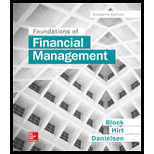
a.
To calculate: The selection of the investment using the PBP method.
Introduction:
Pay-back period (PBP):
It is one of the methods of capital budgeting that helps evaluate the time period in which the amount of initial investment is recovered. The formula for the calculation of the PBP is shown below.
Here,
Year = The year in which the cumulative cash flow is close to and less than the initial investment.
Initial investment = The amount of the investment.
Cumulative cash flow = The cumulative cash flow is close to and less than the initial investment.
Cash flow = The cash flow of the next year from the “Year� used for the calculation.
b.
To explain: The reason why the answer of part (a) is misleading.
Introduction:
Pay-back period (PBP):
It is one of the methods of capital budgeting that helps evaluate the time period in which the amount of initial investment is recovered. The formula for the calculation of the PBP is shown below.
Here,
Year = The year in which the cumulative cash flow is close to and less than the initial investment.
Initial investment = The amount of the investment.
Cumulative cash flow = The cumulative cash flow is close to and less than the initial investment.
Cash flow = The cash flow of the next year from the “Year� used for the calculation.
Want to see the full answer?
Check out a sample textbook solution
Chapter 12 Solutions
Foundations of Financial Management
- AP Associates needs to raise $35 million. The investment banking firm of Squeaks, Emmie, andChippy will handle the transaction.a. If stock is used, 1,800,000 shares will be sold to the public at $21.30 per share. The corporation willreceive a net price of $20 per share. What is the percentage underwriting spread per share?b. If bonds are utilized, slightly over 37,500 bonds will be sold to the public at $1,000 per bond. Thecorporation will receive a net price of $980 per bond. What is the percentage of underwritingspread per bond? (Relate the dollar spread to the public price.)c. Which alternative has the larger percentage of spread?arrow_forwardGracie’s Dog Vests currently has 5,200,000 shares of stock outstanding and will report earnings of$8.8 million in the current year. The company is considering the issuance of 1,500,000 additionalshares that will net $28 per share to the corporation.a. What is the immediate dilution potential for this new stock issue?b. Assume that Grace’s Dog Vests can earn 8 percent on the proceeds of the stock issue in time toinclude them in the current year’s results. Calculate earnings per share. Should the new issuebe undertaken based on earnings per share?arrow_forwardYou plan to contribute seven payments of $2,000 a year, with the first payment made today (beginning of year 0) and the final payment made at the beginning of year 6, earning 11% annually. How much will you have after 6 years? a. $12,000 b.$21,718 c.$19,567 d.$3,741arrow_forward
- What is the full form of "CTO"? a.Central Trading Operation b.Capital take Over c.Chief Technology Officer d.Commerce Trade Officerarrow_forwardExplain. What is the full form of "EPS"? a.Exchange per Share b.Equity Private Selling c.Earnings per share d.Earning Preferred Stockarrow_forwardWhat is the full form of "MMKT"? a.Middle Market b.Management Key Trading c.Money Market d.Mutual Market Tradingexplainarrow_forward
- Principles of Accounting Volume 2AccountingISBN:9781947172609Author:OpenStaxPublisher:OpenStax College
